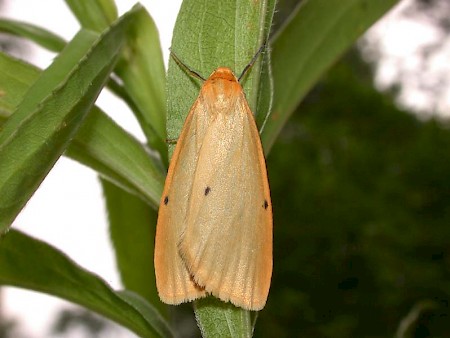Ecaille éborine : Différence entre versions
m (A déprotégé « Ecaille éborine ») |
|||
| (5 révisions intermédiaires par le même utilisateur non affichées) | |||
| Ligne 1 : | Ligne 1 : | ||
[[Category:Insectes]] | [[Category:Insectes]] | ||
| − | <br> | + | [[Image:Four dotted footman Matthias Biere.jpg|Image:Four_dotted_footman_Matthias_Biere.jpg]]<br> Ecaille éborine ''Cybosia mesomella'' (forme jaune)- photo © Matthias Biere |
| − | Ecaille éborine ''Cybosia mesomella'' | + | |
====== Etymologie ====== | ====== Etymologie ====== | ||
| − | *'''Nom latin''' : ''Cybosia mesomella'' | + | *'''Nom latin''' : ''Cybosia mesomella'' |
| − | *'''Nom anglais''' : Four-dotted Footman | + | *'''Autres noms''' : Éborine, Lithosie à quatre points. |
| − | *'''Famille''' : '''Arctiidae'''. | + | *'''Nom anglais''' : Four-dotted Footman |
| + | *'''Famille''' : '''Arctiidae'''. | ||
====== Description ====== | ====== Description ====== | ||
| − | *'''Taille''' : mm | + | *'''Taille''' : 25-33 mm |
| − | * | + | *Ecaille jaunâtre, montrant seulement 3 petits points noirs au repos (l'un est caché par une aile). |
| − | ====== plantes hôtes ====== | + | *'''Il existe deux formes''' : |
| + | **''Cybosia mesomella'' f. ''flava'' (jaune) | ||
| + | **''Cybosia mesomella'' f. ''albescens'' (blanc ivoire) | ||
| + | ====== plantes hôtes ====== | ||
*-- | *-- | ||
====== Répartition ====== | ====== Répartition ====== | ||
| − | * | + | *'''Europe''' sauf l'Espagne, à l'Est jusqu'à l'Oural. |
====== Habitat ====== | ====== Habitat ====== | ||
| − | * | + | *Landes à bruyères et boisements. |
| − | ====== Ecologie ====== | + | ====== Ecologie ====== |
| − | *- | + | *'''Période de vol''' : juin-août. |
====== Statut ====== | ====== Statut ====== | ||
| − | * | + | *Pas de statut de protection connu. |
====== Bibliographie ====== | ====== Bibliographie ====== | ||
| + | |||
*Bebbington John & Lewington Richard (2007) - '''Guide to the hawkmoths of the British Isles'''. Edition Field Studies Council (FSC). | *Bebbington John & Lewington Richard (2007) - '''Guide to the hawkmoths of the British Isles'''. Edition Field Studies Council (FSC). | ||
*Leraut Patrice (2006) - '''Papillons de nuit d'Europe, bombyx, sphinx, écailles...''' VOL I. NAP éditions. | *Leraut Patrice (2006) - '''Papillons de nuit d'Europe, bombyx, sphinx, écailles...''' VOL I. NAP éditions. | ||
Version actuelle datée du 30 septembre 2015 à 15:53

Ecaille éborine Cybosia mesomella (forme jaune)- photo © Matthias Biere
Sommaire
Etymologie[modifier]
- Nom latin : Cybosia mesomella
- Autres noms : Éborine, Lithosie à quatre points.
- Nom anglais : Four-dotted Footman
- Famille : Arctiidae.
Description[modifier]
- Taille : 25-33 mm
- Ecaille jaunâtre, montrant seulement 3 petits points noirs au repos (l'un est caché par une aile).
- Il existe deux formes :
- Cybosia mesomella f. flava (jaune)
- Cybosia mesomella f. albescens (blanc ivoire)
plantes hôtes[modifier]
- --
Répartition[modifier]
- Europe sauf l'Espagne, à l'Est jusqu'à l'Oural.
Habitat[modifier]
- Landes à bruyères et boisements.
Ecologie[modifier]
- Période de vol : juin-août.
Statut[modifier]
- Pas de statut de protection connu.
Bibliographie[modifier]
- Bebbington John & Lewington Richard (2007) - Guide to the hawkmoths of the British Isles. Edition Field Studies Council (FSC).
- Leraut Patrice (2006) - Papillons de nuit d'Europe, bombyx, sphinx, écailles... VOL I. NAP éditions.
- Leraut Patrice (2009) - Papillons de nuit d'Europe, géomètres VOL II. NAP éditions.
- Lewington Richard (2006) - Guide to the day-flying moths of Britain. Edition Field Studies Council (FSC)
- Manley Chris (2008) - British moths and butterflies, a photographic guide. Edition A & C Black.
- Robineau Roland (2007) -Guide des papillons nocturnes de France, plus de 1620 espèces décrites et illustrées. Edition Delachaux & Niestlé.
- Skinner Bernard (2009) -Colour identification guide to moths of the British isles. Edition Apollo Books.
- Townsend M. & Waring P. (2007) -Concise guide to the moths of great Britain and Ireland. Edition British Wildlife Publishing
- Waring Paul & Townsend Martin (2009)- Field guide to the moths of great Britain and Ireland. Edition British Wildlife Publishing.
- Young Mark (1997) -Natural History of Moths. Edition T & AD Poyser Ltd (A & C Black).